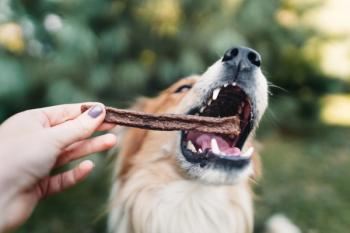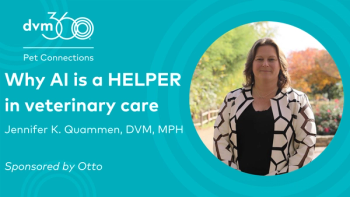
Laryngeal paralysis common, although causes vary
Laryngeal paralysis or paresis is thought to be very common in dogs with a reported incidence as high as 25 percent. (Aust Vet J 2000;78:769-772.)
Laryngeal paralysis or paresis is thought to be very common in dogs with a reported incidence as high as 25 percent. (Aust Vet J 2000;78:769-772.)
Bilateral involvement is seen more commonly than unilateral paralysis although either may occur.
Congenital laryngeal paralysis appears to be inheritable in several breeds (Bouvier de Flandres, Dalmatian, Bull Terrier, Siberian Husky and Siberian Husky mixes).
Acquired laryngeal paralysis can be a clinical sign of other diseases such as peripheral neuropathies (myasthenia gravis), hypothyroidism, trauma (bite wounds, surgery, penetrating esophageal foreign body) or neoplasia. However the majority of acquired laryngeal paralysis is idiopathic and is usually seen in older (> 7 years) large breed dogs (Labrador, Golden Retriever, St. Bernard, Siberian Husky).
Owners commonly seek veterinary attention because of exercise intolerance, stridor, coughing or gagging associated with eating or drinking, or voice changes. Many of these patients are hypoxemic and when stressed or exercised can become severely dyspneic. Secondary pulmonary edema and atelectasis may worsen their respiratory signs. Coughing and gagging during swallowing is due to aspiration of food or water.
Table 1: Suggested Protocol for the Diagnosis of Laryngeal Paralysis
Paralysis of the dorsal cricoarytenoid muscles prevents the abduction of the arytenoids and the vocal folds during inspiration. Because the pressure within the glottis is negative, the arytenoids and vocal folds are drawn in to the paramedian position thereby decreasing the size of the glottic lumen and increasing airflow resistance. This narrowing of the glottic lumen causes an increase in airflow velocity which decreases the lateral pressure (Bernoulli effect), thus precipitating a further airway narrowing. The airway may narrow so much that airflow actually ceases. This results in an increase in lateral pressure and helps to re-open the glottic lumen. This opening/closing cycle in the larynx causes the vocal folds to oscillate which produces the characteristic "roaring" or wheeze known as stridor.
Pathophysiology
Radiographs of the larynx may identify the presence of cervical or laryngeal masses but are not useful in the diagnosis of laryngeal paralysis.
Diagnosis
Thoracic radiographs of severely dyspneic patients should be evaluated for pulmonary edema, atelectasis, and aspiration pneumonia. Blood gas analysis can help determine the degree of respiratory compromise. The definitive diagnosis of laryngeal paralysis is by direct visualization of the larynx under a light plane of anesthesia. If the plane of anesthesia is too deep then the arytenoids may appear paralyzed (remaining in an adducted or paramedian position) leading to an incorrect diagnosis of laryngeal paralysis (VCNA 1994;24:855-871).
The anesthetic itself is thought to possibly decrease intrinsic laryngeal function. A recent study (JVIM 2002;16:524-528) confirmed that the use of doxapram hydrochloride (Dopram-V) to stimulate respiration accentuates intrinsic laryngeal motion. Changes in laryngeal function are therefore more obvious and dramatic in gross appearance after doxapram administration and the authors propose that it be used routinely as an aid in diagnosing laryngeal paralysis. Doxapram has few detrimental effects but is contraindicated in patients with hypertension, seizures, severe hypoxia, or increased intracranial pressure. During laryngoscopy, it is useful to have an assistant watch the animal and inform the person performing the procedure each time the animal inspires. The arytenoids and vocal folds should abduct with each inspiration. Sudden expiratory opening of the glottis as with coughing or sighing should not be confused with inspiratory abduction. Table 1 outlines a suggested procedure for evaluation of laryngeal function.
Initial therapy for respiratory distress from laryngeal paralysis should include supplemental oxygen, corticosteroids, and furosemide if pulmonary edema is present. Some patients may need tranquilization. Conservative therapy (decreased exercise and stress, sedation) is often unsuccessful and surgical correction should be considered. Unilateral arytenoid lateralization is currently the preferred surgical procedure to increase the fixed diameter of the laryngeal airway and provide adequate airflow. Improvement in inspiratory function is seen in as many as 90 percent of patients. Increased inspiratory sounds usually continue after surgery but are less harsh. Coughing may occur with swallowing, but the incidence of aspiration pneumonia after this surgery appears to be low (CVT XII;901-905).
Treatment
Editor's Note: Comments or questions may be directed to Dr. Carol Marks at the Animal Emergency and Referral Center, 3984 S US 1, Fort Pierce, Florida, 34982.
Newsletter
From exam room tips to practice management insights, get trusted veterinary news delivered straight to your inbox—subscribe to dvm360.






